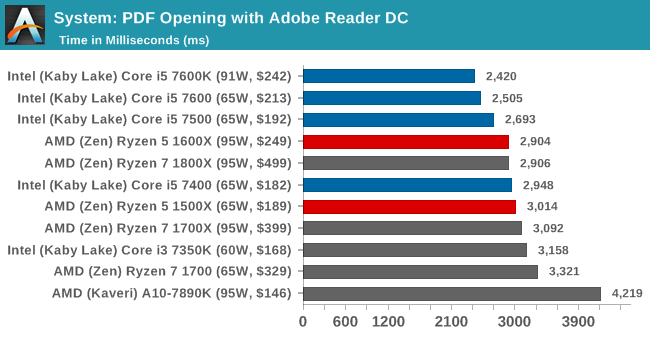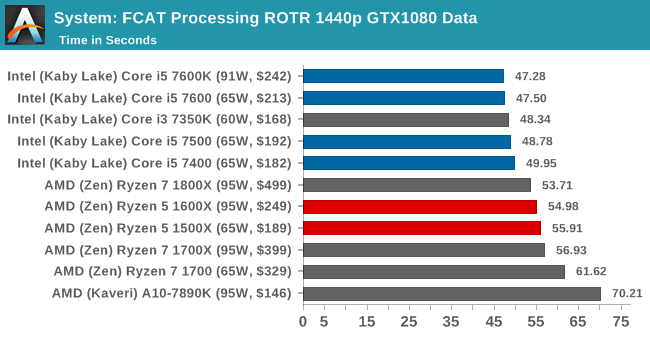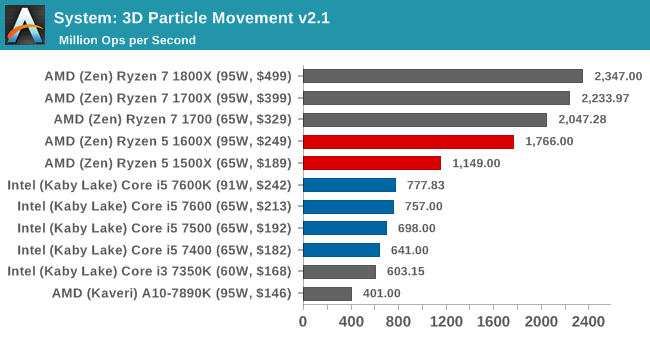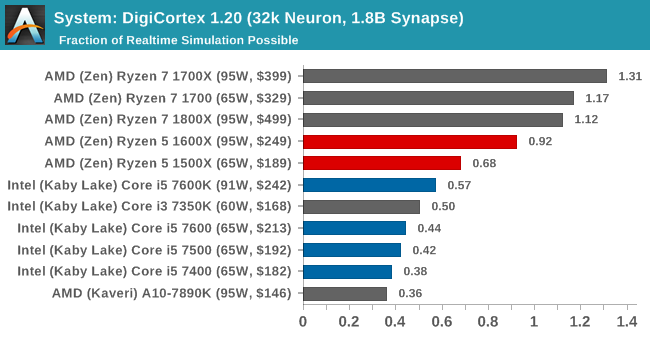The AMD Ryzen 5 1600X vs Core i5 Review: Twelve Threads vs Four at $250
by Ian Cutress on April 11, 2017 9:00 AM ESTBenchmarking Performance: CPU System Tests
Our first set of tests is our general system tests. These set of tests are meant to emulate more about what people usually do on a system, like opening large files or processing small stacks of data. This is a bit different to our office testing, which uses more industry standard benchmarks, and a few of the benchmarks here are relatively new and different.
PDF Opening
First up is a self-penned test using a monstrous PDF we once received in advance of attending an event. While the PDF was only a single page, it had so many high-quality layers embedded it was taking north of 15 seconds to open and to gain control on the mid-range notebook I was using at the time. This put it as a great candidate for our 'let's open an obnoxious PDF' test. Here we use Adobe Reader DC, and disable all the update functionality within. The benchmark sets the screen to 1080p, opens the PDF to in fit-to-screen mode, and measures the time from sending the command to open the PDF until it is fully displayed and the user can take control of the software again. The test is repeated ten times, and the average time taken. Results are in milliseconds.

Opening PDFs using Adobe is significantly single threaded, hence why Intel takes the win here for the most part - the 7400 is slightly lower on frequency, enough for the 4.0 GHz Ryzen parts to push ahead.
FCAT Processing
One of the more interesting workloads that has crossed our desks in recent quarters is FCAT - the tool we use to measure stuttering in gaming due to dropped or runt frames. The FCAT process requires enabling a color-based overlay onto a game, recording the gameplay, and then parsing the video file through the analysis software. The software is mostly single-threaded, however because the video is basically in a raw format, the file size is large and requires moving a lot of data around. For our test, we take a 90-second clip of the Rise of the Tomb Raider benchmark running on a GTX 980 Ti at 1440p, which comes in around 21 GB, and measure the time it takes to process through the visual analysis tool.
Similarly, FCAT is single threaded as it analyzes frame-by-frame. The extra frequency helps Intel here.
3D Particle Movement v2.1
This is the latest version of the self-penned 3DPM benchmark. The goal of 3DPM is to simulate semi-optimized scientific algorithms taken directly from my doctorate thesis. Version 2.1 improves over 2.0 by passing the main particle structs by reference rather than by value, and decreasing the amount of double->float->double recasts the compiler was adding in. It affords a ~25% speed-up over v2.0, which means new data.
DigiCortex 1.20
Despite being a couple of years old, the DigiCortex software is a pet project for the visualization of neuron and synapse activity in the brain. The software comes with a variety of benchmark modes, and we take the small benchmark which runs a 32k neuron/1.8B synapse simulation. The results on the output are given as a fraction of whether the system can simulate in real-time, so anything above a value of one is suitable for real-time work. The benchmark offers a 'no firing synapse' mode, which in essence detects DRAM and bus speed, however we take the firing mode which adds CPU work with every firing.
Agisoft Photoscan 1.0
Photoscan stays in our benchmark suite from the previous version, however now we are running on Windows 10 so features such as Speed Shift on the latest processors come into play. The concept of Photoscan is translating many 2D images into a 3D model - so the more detailed the images, and the more you have, the better the model. The algorithm has four stages, some single threaded and some multi-threaded, along with some cache/memory dependency in there as well. For some of the more variable threaded workload, features such as Speed Shift and XFR will be able to take advantage of CPU stalls or downtime, giving sizeable speedups on newer microarchitectures.

Because parts of Photoscan are very multithreaded, such as the first stage, there's plenty of scope for the Ryzen CPUs to pull ahead here.













254 Comments
View All Comments
Bp_968 - Sunday, April 16, 2017 - link
This is the point I try to make all the time to console players saying PCs cost too much, require too much upgrading. My i7 970 or 980 (I forget!) Is still playing modern games wonderfully @2560x1440 with a gtx 970. We reciently built a pc for my neighbor out of spare parts and he ended up with a core2 quad (q6600 maybe?) With 6gb ram and a gtx460. He quickly upgraded to a gtx 1050 and now it easily stomps his PS4 (and probably the PS4pro).I'm with one of the previous posters about chipset accessories. It won't be CPU speed that causes me to up upgrade, it will be me wanting access to new features (pcie4, usb-c, usb3.1/3.2, NVMe, Intels ddr/ssd hybrid memory interface, etc etc).
I also expect Intel to respond, at least in the ryzen7 market. I really hope it means Intel will finnally start offering 6-8 core CPUs in non-silly price points.
mmegibb - Tuesday, April 11, 2017 - link
The choice of software hardly matters when what you are looking for is a collection of software that exercises the entire CPU subsystem: the cores, caches, memory, etc. As th3ron mentions, what matters is finding the deltas between CPUs.And yes, in spite of your snobbery, probably 50% of people reading this want to size their system for gaming. Gaming is the limiting case for my home builds.
psychobriggsy - Wednesday, April 12, 2017 - link
Indeed gaming is important for many people.What the reviews show is that for a mixed-use system, the gaming aspect is not significantly behind Intel alternatives (obviously a couple of outliers, but that applies in both directions). However for the other uses, Ryzen is a complete win. It's good enough, rather than the pile of fail that Bulldozer core CPUs were. And indications are that games are getting more multithreaded over time, so buying a 4C product is limiting future gaming.
It's clear that Intel will have to enable SMT in their i5 refreshes this year now, as that should let them claw something back in the 'partial multithreaded' use cases (apps that can't scale indefinitely with extra cores but top out at 4-8 threads).
IanHagen - Tuesday, April 11, 2017 - link
I completely agree on that. I'd love to see more compiling benchmarks too. It's coming to the point where people who are buying a CPU for productivity are taking decisions drawn upon conclusions heavily influenced by gaming performance.RafaelHerschel - Wednesday, April 12, 2017 - link
50% of people use a fast CPU for gaming is a very conservative estimate. For regular office work or for media consumption an inexpensive CPU is fast enough. The current Intel Celeron and Pentium CPUs (or the AMD equivalent) offer much better value for most people. Because of marketing i3 and i5 CPUs sell well.And there are more gamers than professionals who use software that benefits from fast CPUs.
ddriver - Wednesday, April 12, 2017 - link
Dunno about that, of all the people I know who have powerful machines, all do professional work, even those who game. Then again, the selection of my acquaintances has to do with their skills, and I do have to admit I have zero interest in interacting with someone who only plays games.I also know that is 99% of the games on the market cannot utilize 66.66% of that chip.
So you end up putting 50% of the review emphasis on tests that can only utilize 1/3 of the chip.
It is like... testing a sports car and putting 50% of the emphasis on its use as a hearse that will never be used at nowhere near its potential.
mmegibb - Wednesday, April 12, 2017 - link
Man, ddriver, you are an elitist jerk. "I have zero interest in interacting with someone who only plays games". Also, "People who use winrar most likely do not make logical considerations, because if they did, they wouldn't be using garbage like winrar".Why are you like that?
vladx - Wednesday, April 12, 2017 - link
Don't mind ddriver, he's just a pathetic troll who tries too hard.Meteor2 - Wednesday, April 12, 2017 - link
I imagine the proportion of PCs containing higher than i5-7400s bought by consumers used for gaming is much higher than 50%.*Not* talking about business buys here, I'm talking about people spending their own money.
Meteor2 - Wednesday, April 12, 2017 - link
D'oh, I just replied to ddriver. What was I thinking.